The problem of excessive adhesion of transparent dressings is not uncommon. Generally speaking, transparent dressings are designed to provide good adhesion to ensure that they can firmly cover the wound and prevent the invasion of external bacteria. However, excessive adhesion can sometimes cause discomfort or even damage the skin. Usually, the reasons for excessive adhesion may include factors such as the adhesive components of the dressing, the skin condition at the wound, and the influence of the external environment.
The adhesive of the transparent dressing is the key factor in determining the adhesion strength. Different manufacturers may use different types of adhesives, and the adhesion strength of these adhesives varies greatly. Some transparent dressings use stronger adhesives in their formulations to increase durability. Secondly, the humidity of the wound will also affect the adhesion of the dressing. If the wound is relatively moist, the transparent dressing may adhere more firmly to the skin. Factors such as changes in the external climate, the patient's skin type, and the use time of the transparent dressing may also cause the occurrence of adhesion problems.
Excessive adhesion of transparent dressings may cause a series of discomforts. First, excessive stickiness may cause pain when changing the dressing, especially in sensitive areas of the skin. If the dressing is too sticky, it may also cause damage to the surface of the skin, or even tear the skin. In addition, the excessive stickiness of the transparent dressing may also affect the patient's comfort, making them feel stuffy or have a foreign body sensation. For patients who need to use the dressing for a long time, this discomfort may affect their daily life.
The excessive stickiness of the transparent dressing may also affect the healing of the wound. If the adhesive layer formed on the surface of the wound is too tight, it may hinder the effective communication between the wound and the outside world, making it difficult for the wound to breathe, thereby affecting the healing process. More seriously, when removing the dressing, the excessive stickiness may pull the skin, causing secondary damage to the wound, and even aggravating the inflammatory response of the wound surface.
For the situation where the transparent dressing is too sticky, there are several solutions to help reduce the discomfort and skin damage caused by stickiness. First, you can try to choose a transparent dressing that suits your skin type. In the market, there are many types of transparent dressings with different stickiness strengths. Some manufacturers have designed transparent dressings with milder adhesion specifically for patients with sensitive skin or those who use dressings for a long time. Therefore, choosing a dressing that suits your situation is the first step to solve this problem.
Consider using a less sticky type of dressing. For example, some transparent dressings are designed with low self-adhesion. Although their adhesion may not be as strong as some conventional dressings, they can still be effectively fixed to the wound without excessive pressure on the skin. For some special areas, you may even consider using other types of dressings, such as bandages or ointments, which have relatively low adhesion and are more suitable for patients with more fragile skin.
When dealing with the problem of excessive adhesion of transparent dressings, it is also very
important to adjust the environment around the wound. For example, keeping the wound area dry can help reduce the stickiness of the dressing. An overly humid environment may increase the adhesion between the dressing and the skin, so keeping the wound dry can effectively alleviate this problem. For patients with more sensitive skin, some skin protection films can be used where the dressing contacts the skin to reduce the discomfort caused by direct contact.
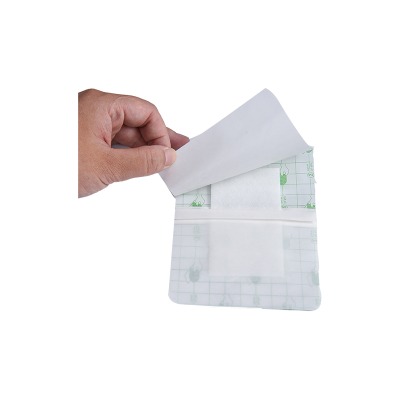
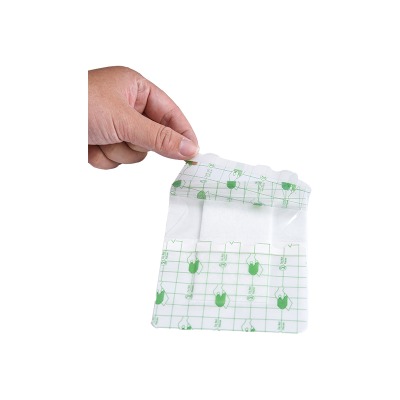
When the stickiness of transparent dressings is too strong, the correct replacement and removal method is particularly important. If you don't pay attention to the method, it may aggravate skin damage and cause more severe discomfort. First, when changing the dressing, you can gently loosen a corner of the dressing and try to avoid tearing it hard to reduce the pulling on the skin. For some dressings with strong stickiness, you can first moisten the edge of the dressing with warm water to make it easier to peel off. After moistening, you can slowly remove the dressing along the direction of the skin to avoid trauma caused by straight pulling.
In order to avoid the discomfort caused by the strong stickiness of transparent dressings, it is best to take segmented operations when removing them. Divide the dressing into several sections for removal, and remove a small section at a time to avoid the pain caused by removing the entire dressing at one time. This can reduce the pulling on the skin, especially the skin around the wound. During the removal process, try to avoid violent operations, and should proceed step by step so that the dressing can be completely removed without causing damage.
In order to avoid the problem of excessive stickiness of transparent dressings, you should pay attention to some details when using them. First, before using a transparent dressing, you should make sure that the skin around the wound is clean and free of any contamination. Grease, dirt or sweat can affect the adhesion of the dressing, resulting in excessive stickiness. Ensuring that the skin surface is clean helps to maintain the stability of the dressing's stickiness and avoid too strong or too weak adhesion.
The frequency of changing the transparent dressing also needs to be determined according to the healing of the wound. If the wound has gradually healed, the time for changing the transparent dressing can be appropriately extended. Frequent dressing changes may cause skin friction, which in turn aggravates the problems caused by excessive stickiness. Therefore, according to the actual situation of the wound, a reasonable arrangement of the dressing change time can effectively reduce damage to the skin.
The patient's skin type is also a factor that needs to be considered. Patients with more sensitive skin should choose transparent dressings with lower stickiness to avoid excessive burden on the skin. For patients who often use dressings, it is recommended to check the skin condition regularly. If redness, swelling, allergies and other reactions are found, the type or method of use of the dressing should be adjusted in time.
Transparent dressings are widely used in wound care, but some people may experience allergic reactions. Allergic reactions to transparent dressings are usually caused by the adhesive ingredients or other chemicals contained in them. The adhesive ingredients of transparent dressings are mostly synthetic, and some patients' skin reacts allergicly to these ingredients, causing discomfort symptoms such as redness, swelling, and itching.
The adhesives used in transparent dressings are the most common allergens. Some adhesives, such as acrylic adhesives, may react chemically with the skin, especially for some sensitive people, which may cause local allergic reactions. Secondly, the outer packaging material or surface coating of transparent dressings may also contain certain allergens. Although these ingredients do not cause problems under normal circumstances, they may still induce allergic reactions in individuals with allergic constitutions.
The use of transparent dressings for too long or poor local skin conditions will also increase the risk of allergies. If the dressing is in contact with the skin for a long time, or there are trauma, ulcers, etc. on the skin, the transparent dressing may have stronger contact with the skin, increasing the chance of allergies. External environmental factors such as moisture and temperature may also aggravate allergic symptoms.
Symptoms of allergic reactions to transparent dressings usually manifest as skin redness, swelling, itching, burning sensation, etc. Mild allergic reactions may only manifest as slight redness and discomfort of the local skin, while more severe allergic reactions may cause blisters, peeling, desquamation, etc. on the skin.
Redness and itching are the most common symptoms. When transparent dressings react allergically with the skin, the patient's skin may show obvious redness and swelling, accompanied by itching. At this time, the skin usually feels uncomfortable, and the patient may scratch unconsciously, further aggravating the allergic reaction. Secondly, a burning sensation on the skin is another common symptom. The patient may feel an increase in the temperature of the skin in the dressing area, and even feel like sunburn. In severe cases, blisters may form in the dressing area, and the skin may become fragile and prone to rupture, causing greater discomfort to the patient.
For some individuals with more severe allergies, the use of transparent dressings may cause large areas of erythema or peeling on the skin. These symptoms are usually accompanied by severe pain and discomfort. If the allergic reaction worsens further, it may lead to wound infection, slow wound healing, and other problems. Allergic reactions may also cause systemic symptoms such as local lymphadenopathy or fever, especially in people with more sensitive immune systems.
When an allergic reaction to a transparent dressing occurs, the first step should be to remove the dressing immediately. Gently remove the dressing from the wound area, avoiding tearing it hard to reduce further damage to the skin. After removing the dressing, gently wash the allergic area with warm water to remove any adhesive or other allergens that may remain.
Mild skin care products can help relieve allergic symptoms. After the allergic area is clean, you can apply some moisturizer or anti-allergic ointment, such as topical ointment containing loratadine. Moisturizers can help repair the skin barrier and reduce dryness and scaling. For more severe allergic symptoms, ointments containing corticosteroids can be used to relieve inflammation, reduce redness, swelling and itching. However, when using any medication, it is best to do so under the guidance of a doctor to ensure the safety and effectiveness of the medication.
Cold compresses are also one of the effective ways to relieve allergic reactions. Wrapping an ice pack or wet towel in a clean cloth and gently applying it to the allergic area can help relieve inflammation and itching. Cold compresses can help constrict blood vessels and reduce the spread of allergic reactions, thereby reducing the patient's discomfort.
If the initial treatment method does not significantly relieve the allergic reaction, or the allergic symptoms continue to worsen, you should seek medical attention in time. The doctor may provide a more professional treatment plan based on the patient's specific situation. In some severe allergic reactions, the doctor may recommend the use of oral antihistamines to relieve allergic symptoms. Antihistamines can effectively inhibit allergic reactions and reduce symptoms such as itching, redness and swelling.
For patients with severe symptoms such as blisters and ruptures on the skin, the doctor may prescribe antibiotics according to the situation to prevent secondary infections. In addition, if the patient's allergic reaction is related to abnormalities in the immune system, further immune testing or allergen testing may be required to determine whether there are other potential allergens.
If the allergic reaction is more severe or acute symptoms such as anaphylactic shock occur, the patient should go to the emergency department immediately. Acute allergic reactions need to be treated quickly to avoid further deterioration of the condition and life-threatening.
To prevent allergic reactions to transparent dressings, first of all, you should choose a dressing that suits your skin type. For patients with sensitive skin, it is recommended to choose a low-sensitivity transparent dressing and try to avoid using dressings containing strong chemical ingredients. Some manufacturers have produced transparent dressings designed for sensitive skin. These dressings have a milder viscosity and safer ingredients, which can reduce the risk of allergies.
When using transparent dressings, you should follow the correct usage method to avoid prolonged contact between the dressing and the skin. Transparent dressings should be replaced in time during use, especially in the early stages of wound healing. Prolonged contact increases the risk of skin allergies, so regular replacement of dressings can effectively prevent skin discomfort.
If you are unsure about certain ingredients, patients can perform skin tests on a small area. Apply a small amount of dressing or its related ingredients to the non-wound area of the skin and observe whether allergic reactions such as redness, swelling, and itching occur within 24 hours. Through skin testing, you can effectively determine whether you are allergic to a certain ingredient and reduce the occurrence of allergic reactions.
Transparent dressings are widely used in the medical field, especially in wound care. It is mainly composed of a highly breathable film and an adhesive layer, which can effectively protect the wound from external contamination and promote wound healing. Transparent dressings have good transparency, allowing medical personnel to directly observe the healing of the wound, which is convenient for monitoring and treatment. In addition, transparent dressings also have a certain degree of waterproofness, which can reduce the entry of moisture into the wound in daily life and prevent infection. However, the most critical question in the use of transparent dressings is: how often should it be changed? Reasonable replacement frequency is crucial for wound healing. Too frequent replacement will affect the healing process, while too few replacements may cause infection or other complications.
The frequency of transparent dressing replacement is affected by many factors, including the type and location of the wound, the degree of wound healing, the type of dressing, the external environment, and the patient's physical condition. Each wound heals at a different speed, and the time to use transparent dressings should also vary depending on the actual situation of the wound.
The type and location of the wound have an important impact on the frequency of transparent dressing replacement. For example, surface wounds usually heal faster, while deeper wounds require longer care and more frequent dressing changes. For wounds with larger wounds or more exudate, dressings need to be changed more frequently to prevent the dressings from getting wet and reducing their protective effect on the wound. For wounds after surgery, especially when there are sutures at the surgical site, the doctor will recommend the frequency of change based on the surgical situation and the recovery of the wound.
The healing of the wound is also an important factor in determining the frequency of dressing changes. For wounds that heal well, the dressing can be appropriately extended to extend the replacement cycle, because the wound has gradually healed and no longer requires excessive protection and closure. For wounds that are secreting exudate or infected, dressings should be changed more frequently to keep the wound clean and dry and avoid bacterial growth.
External environment such as climate change, humidity, temperature, etc. will also affect the replacement time of transparent dressings. In a humid or warm environment, the dressing may become damp, resulting in reduced adhesion and affecting the protective effect of the wound. At this time, the dressing needs to be changed more frequently to ensure that it can effectively isolate external contamination.
The time for changing transparent dressings is usually determined by the condition of the wound and the type of transparent dressing. Generally speaking, the recommended frequency of changing transparent dressings is every 2-3 days, but this is not a fixed standard and should be adjusted according to actual conditions.
For small wounds or surface wounds, if there is no exudate or infection, it is usually recommended to change the dressing every two days. Such wounds heal faster, and the main function of transparent dressings is to prevent bacterial invasion and protect the wound. Therefore, regular dressing changes can ensure the cleanliness and safety of the wound. For larger wounds or postoperative wounds, doctors may recommend changing the dressing every day until the wound heals to a certain extent. Especially in the early postoperative period, changing the dressing helps reduce the risk of infection and keep the wound dry and clean.
For deeper wounds or wounds with obvious exudate, the frequency of changing transparent dressings may need to be increased. Due to the large amount of exudate in these wounds, the dressing will become moist and cannot effectively keep the wound dry and clean. Therefore, it is recommended to check the wound condition every day. If the dressing has exudate or the adhesion decreases, it should be changed in time. For patients who need to use transparent dressings for a long time, the type and brand of transparent dressings will also affect the frequency of replacement. Different brands of dressings have different air permeability, viscosity and water resistance. Patients should judge the timing of replacement based on the actual use effect.
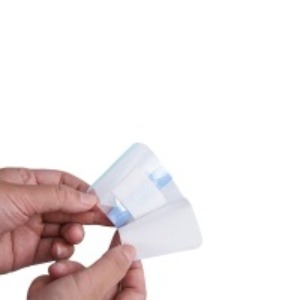
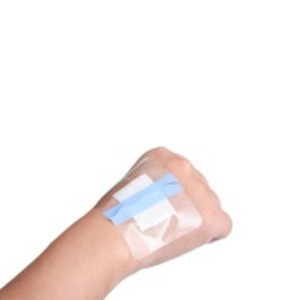
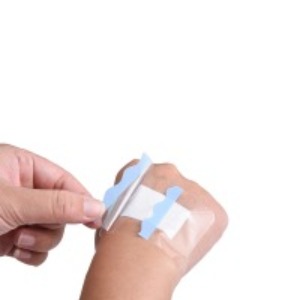
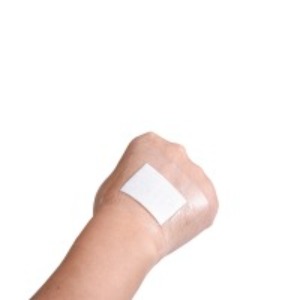
The timing of whether transparent dressings need to be replaced can be determined by observing the appearance of the dressing and the condition of the wound. First of all, if the transparent dressing becomes obviously wet, falls off or is damaged, it means that the protective effect of the dressing has weakened and needs to be replaced in time. If there is a large amount of exudate or blood on the surface of the dressing, the absorption capacity of the dressing has reached saturation and needs to be replaced as soon as possible to avoid affecting the healing of the wound.
Observing the state of the wound is also an important basis for judging whether the transparent dressing needs to be replaced. If there are inflammatory symptoms such as redness, swelling, and fever around the wound, it may be a manifestation of wound infection. At this time, the dressing needs to be replaced as soon as possible and consult a doctor. In addition, if the wound healing progresses quickly, the transparent dressing should also be replaced in time, because as the wound heals, the protection needs of the transparent dressing will decrease. In other words, when wound exudate is significantly reduced or the wound is closed, the dressing can be appropriately extended to extend the replacement interval.
For patients who use transparent dressings in some special circumstances, such as diabetics or patients with weak immune systems, the wound may heal slowly, so it is necessary to check the wound regularly and change the dressing in time to ensure that the wound will not cause infection due to the dressing sticking too long.
When changing transparent dressings, patients should pay attention to some details to ensure that the wound is effectively cared for. First, keep your hands clean when changing the dressing, use sterile gloves or clean tools to prevent secondary contamination. Secondly, be careful when removing the dressing and avoid tearing it hard to avoid causing additional damage to the wound or surrounding skin.
When changing a new dressing, make sure the wound is clean and dry. If there is secretion or dirt on the surface of the wound, it should be gently washed with warm water or sterile saline, and then wiped clean with a sterile cotton swab. After cleaning, you can choose a suitable dressing to cover it according to the needs of the wound. If the transparent dressing cannot completely cover the wound, consider using other types of dressings to ensure that the wound is fully protected.
For patients who use transparent dressings for a long time, it is necessary to check the skin condition regularly, especially for patients with sensitive skin, as long-term use of dressings may cause allergies or irritation. Therefore, the contact area between the dressing and the skin should be checked regularly to deal with skin discomfort in time.
Sensitive skin refers to the type of skin that is easily affected by the external environment, chemical composition or physiological changes and causes discomfort. Sensitive skin usually manifests itself as thin, fragile, easy to red, easy to inflamed, and may have symptoms such as stinging, itching, and dryness. This type of skin is easily affected by external stimuli such as climate change, allergens, cosmetics, etc., causing skin discomfort or aggravating symptoms. Therefore, sensitive skin requires special care and products, especially when choosing dressings, it is necessary to pay more attention to its mildness to the skin.
As a common wound care product, transparent dressings are widely used because of their good breathability and ability to effectively protect wounds from contamination. However, for patients with sensitive skin, it is particularly important to choose a suitable transparent dressing. Because if the dressing is not properly selected, it may cause additional stimulation to sensitive skin, leading to skin discomfort, allergies and other reactions. Therefore, transparent dressings for sensitive skin must have strong skin adaptability and a mild formula to avoid causing skin discomfort.
Transparent dressings suitable for sensitive skin usually have several significant characteristics. First, transparent dressings should be made of non-irritating materials and should not contain fragrances, alcohol, natural glue or other chemical ingredients that may cause allergies. Secondly, the stickiness of the dressing should be moderate and not too strong to avoid tearing the skin and causing additional damage or irritation. The surface of the transparent dressing should be soft and smooth to reduce friction on the skin and avoid excessive pressure or damage.
Transparent dressings suitable for sensitive skin should also have good breathability and moisture regulation functions. Overly airtight dressings may cause excessive moisture in the wound or skin, increasing the risk of infection, especially for people with sensitive skin, where long-term moisture may cause skin damage or inflammation. Dressings with good breathability can maintain appropriate humidity and help the skin repair itself.
The thickness and flexibility of transparent dressings are also crucial. Dressings with moderate thickness can provide adequate protection and reduce the impact of external stimuli on the wound, while dressings with good flexibility can fit the skin firmly without affecting comfort and reduce discomfort.
Although transparent dressings generally have good protective effects, their use may bring some potential effects to people with sensitive skin. First, excessive adhesion of the dressing may cause skin damage during removal, especially when removing the dressing, which may cause additional pulling and irritation to the skin in sensitive areas. Second, the adhesive ingredients of some transparent dressings may cause allergic reactions in some sensitive individuals, causing discomfort symptoms such as redness, swelling, and itching, especially those containing synthetic chemical ingredients.
If the material of the transparent dressing is not soft enough or not suitable for sensitive skin, it may increase skin friction and cause skin dryness or inflammation, especially in the case of long-term adhesion. Therefore, for people with sensitive skin, it is particularly important to choose the right transparent dressing, and it must be ensured that its ingredients are safe, non-irritating, and comfortable.
There are many transparent dressing brands on the market, and products from different brands vary in ingredients, performance, comfort, etc. For people with sensitive skin, the product's ingredient list and instructions for use should be focused on when choosing. The following are some selection criteria and recommended brands for transparent dressings suitable for sensitive skin:
Ingredient safety: When choosing a transparent dressing, first check whether it contains allergen ingredients, such as fragrances, alcohol, natural glue, etc. People with sensitive skin should choose products that are labeled "hypoallergenic" or "free of irritating chemical ingredients." Brands such as Nolato and Omron often provide transparent dressings that are allergy-tested and suitable for sensitive skin.
Breathability and comfort: Choosing transparent dressings with good breathability can help the skin maintain proper moisture while avoiding excessive moisture in the wound. Transparent dressings provided by brands such as Johnson & Johnson and Medtronic have good breathability and comfort, which can reduce the burden on sensitive skin.
Adhesiveness and flexibility: People with sensitive skin should choose transparent dressings with moderate viscosity to avoid excessive adhesion and skin discomfort. Milder adhesives, such as water-based adhesives, are suitable for sensitive skin. In addition, transparent dressings with good flexibility can ensure that the dressing fits the skin firmly without causing discomfort.
Non-toxic and harmless materials: Choosing non-toxic and harmless transparent dressings can reduce damage to the skin, especially for the wound healing process, to avoid harmful ingredients causing additional burden on the skin.
When using transparent dressings, even if you choose products suitable for sensitive skin, you still need to pay attention to some usage matters to ensure that the wound is effectively protected and avoid excessive irritation to the skin. First, before using the transparent dressing, make sure the wound area is clean and dry. If the wound area is moist or has secretions, it may affect the fitting effect and adhesion of the dressing, so it should be gently wiped clean before use.
Avoid excessive friction during the use of transparent dressings. Even for transparent dressings suitable for sensitive skin, excessive friction may still cause skin discomfort or damage. Avoid repeatedly touching the dressing or rubbing the wound area during use.
The replacement frequency of transparent dressings should also be adjusted according to the condition of the wound and the instructions for use. If the wound exudates more, the dressing should be replaced in time to keep the wound dry and clean. If the dressing falls off, loosens, etc., it should also be replaced in time.
For people with sensitive skin, when using transparent dressings, in addition to choosing suitable products, they also need to do daily care. First, make sure the skin is well moisturized. Sensitive skin is prone to dryness, and long-term use of transparent dressings may aggravate the dryness of the skin, so a mild moisturizer should be used regularly to keep the skin hydrated and smooth.
During the use of transparent dressings, avoid the use of irritating cosmetics or skin care products. For sensitive skin, avoid using products containing irritating ingredients such as alcohol, fragrances, acids, etc. to prevent irritation and allergies.
In daily life, avoid excessive stimulation from the external environment, such as strong sunlight, cold weather, etc. If you need to go out for a long time, try to avoid exposure to the sun after using transparent dressings, or wear appropriate protective measures.
Hyperexudative wounds usually refer to those with a large amount of exudate. Such wounds are often accompanied by a strong inflammatory response, which may be caused by a variety of reasons, such as infection, chronic diseases (such as diabetes, varicose veins, etc.), or trauma. The exudate of the wound may include clear water-like fluid, purulent fluid, etc., which manifests as moisture and swelling in the wound area, and may even penetrate the outside of the dressing. Hyperexudative wounds require special care to avoid further infection of the wound and promote wound healing.
For the treatment of hyperexudative wounds, the choice of dressing is crucial. The right dressing can effectively absorb exudate, keep the wound dry, prevent bacterial invasion, and provide a suitable moist environment for wound healing. However, different types of dressings have different adaptability to hyperexudative wounds. As a common wound care material, the application of transparent dressings in hyperexudative wounds needs to be carefully considered.
Transparent dressings are a kind of film dressing with good air permeability, with certain viscosity and waterproofness, and are usually used for wound protection and care. An important feature of transparent dressings is their transparency, which allows caregivers to clearly see the healing of wounds without removing the dressings. Transparent dressings are usually made of polyurethane film, which has good elasticity and adaptability and can fit closely to the wound surface.
Transparent dressings are suitable for the care of superficial wounds, such as minor abrasions, cuts, postoperative wounds, etc. This type of dressing can provide certain protection, reduce external contamination, and maintain a moist environment for the wound, which is conducive to the natural healing of the wound. However, for highly exudative wounds, the application of transparent dressings needs to consider its ability to absorb exudate and its effect in keeping the wound dry.
Although transparent dressings have their unique advantages, their application in highly exudative wounds still faces certain challenges. First, highly exudative wounds are characterized by large amounts of exudate, while the absorption capacity of transparent dressings is relatively limited. Since the material of transparent dressings is mainly thin film, it does not have strong hygroscopicity and cannot effectively absorb excessive wound exudate. If the wound exudates a lot, the transparent dressing may quickly become saturated, causing the exudate to overflow, and may even affect the adhesion and stability of the dressing.
The moist environment of highly exudative wounds may increase the risk of infection. Although transparent dressings are breathable, they cannot effectively control the moisture of the wound like some dressings designed to absorb moisture. If the transparent dressing cannot absorb the exudate or be changed in time, it may cause the surface of the dressing to be moist, which in turn promotes bacterial growth and affects the healing process of the wound.
Despite certain challenges, transparent dressings can still be used to care for highly exudative wounds in some cases. Its applicability mainly depends on the amount of exudate in the wound, the depth of the wound, and the type of transparent dressing. For wounds with less or moderate exudate, transparent dressings can provide effective protection while keeping the wound clean and moist.
If the wound exudates a lot, transparent dressings may not be ideal. At this time, you should consider choosing more absorbent dressings, such as gauze dressings or foam dressings, which can better absorb exudate and reduce the risk of infection caused by exudate accumulation. Transparent dressings are usually used for high exudate wounds with less exudate or that have been controlled by other methods as the final protective layer of the wound.
For the care of high exudate wounds, in addition to choosing the right dressing, there are several key elements to pay attention to. First, wound cleaning and disinfection are essential. Only on the basis of keeping the wound clean can infection be effectively prevented and wound healing be promoted. Secondly, the dressing should be changed in time according to the change of wound exudate. For high exudate wounds, the frequency of dressing changes may be higher to prevent exudate accumulation and keep the wound dry.
Caregivers should pay close attention to the healing of the wound and observe whether there are signs of infection, such as redness, swelling, fever, pus, etc. If these symptoms occur, appropriate measures should be taken immediately, and it may be necessary to replace the dressing with a more absorbent dressing or use antimicrobial drugs to control the infection.
For highly exudative wounds, in addition to transparent dressings, there are also some dressings designed specifically for highly exudative wounds. The following are several common alternatives:
Foam dressings: Foam dressings have strong hygroscopicity and can effectively absorb the exudate of highly exudative wounds, reduce the accumulation of moisture around the wound, and thus reduce the risk of infection. Foam dressings are often used for wounds with high exudate, such as chronic ulcers, burns, etc.
Gauze dressings: Gauze dressings are the most common traditional dressings with strong exudate absorption capacity. For highly exudative wounds, gauze dressings can effectively absorb exudate, keep the wound dry, and reduce bacterial growth.
Hydrogel dressings: Hydrogel dressings are suitable for wounds that need to maintain a moist environment. Although they are not as hygroscopic as foam dressings, they can provide a certain moist environment, help promote wound healing, and also relieve wound pain.
contact us
Don't hesitate to contact when you need us!